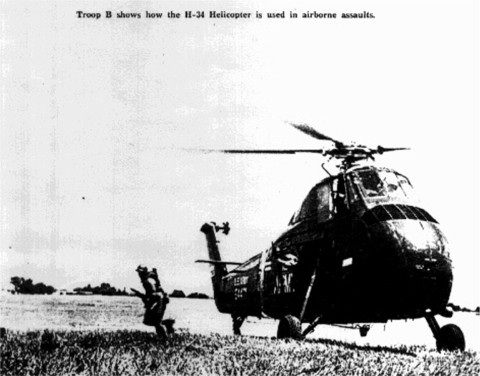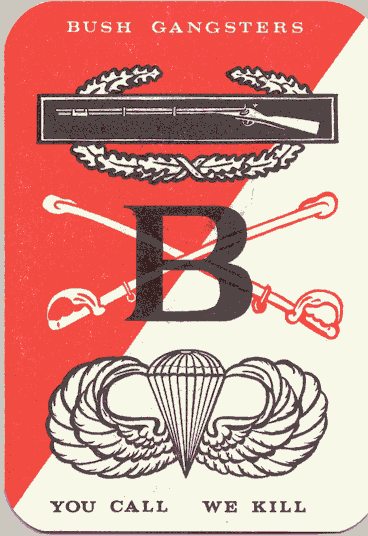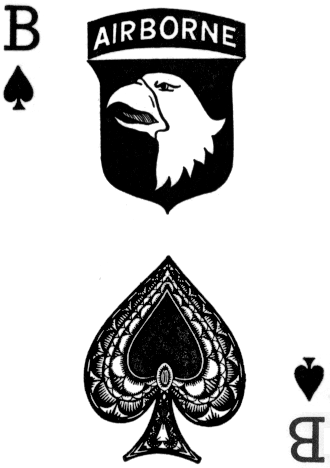
| ABOUT | HOME PAGE | PHOTOS |
It is a privilege to join in welcoming the 101st Airborne Division at the moment of its reactivation as a combat division of the United States Army. The magnificent fighting exploits of the 'Screaming Eagles' in World War II - their intrepid assaults by parachute and glider in Normandy and Holland, their heroic defense of beleaguered Bastogne - rank with the greatest achievements in the annals of military service. It is fitting that the new 101st Airborne should pioneer as the prototype of the Army division of tomorrow, setting a pattern for the fast moving, hard hitting, fully streamlined forces required to cope with the unprecedented conditions of warfare in the atomic age. The glorious record of the 101st Airborne should be a source of pride and satisfaction to all its present members, many of whom helped to write the record. We have every reason to be proud of the part it is destined to play in the future to ensure that our Army will ever be ready, if the need should arise, to meet and defeat any enemy, any place, any time, and under any circumstances.
William M. Brucker
Secretary of the Army
21 September 1956
To the officers and Men of the 101st Airborne Division
As the wartime commander of the 101st Airborne Division, it is a source of particular happiness to me to participate in the activation of this great unit. The 101st Airborne Division was one of the two first Airborne Divisions of the United States Army. From the onset, there was a feeling that this division had a 'rendezvous with destiny.' Its subsequent history in the course of World War II verified this premonition. It was the honor of the 101st to spearhead the invasion of Normandy, the greatest military operation in the history of warfare. Although its operational plan in the landing was bold and difficult, the Division executed all parts of the plan with complete success.
Later in September, 1944, in Holland, the division was one of the principal combat elements in the greatest airborne operation of the war. Here the Division again always took all its objectives, displaying dash and initiative in the course of severe fighting.
It was the lot of this Division to be called upon to hold the key position at Bastogne during the last desperate German effort to break through the Allied front in the Ardennes. The defense of Bastogne has been a source of admiration of friend and foe alike, resulting in the award of the first Presidential Citation to an entire division.
While the newly activated Division has in its ranks some of the wartime veterans of the 'Screaming Eagles,' most of its members are new to the unit. I would charge them to carry forward the magnificent record of the Division into the future, bearing in mind their obligation to their forebears to maintain the reputation of the 101st established in World War II. The members of this division have an unusual opportunity to participate in the development of a new divisional concept of the organization. The 101st Airborne Division has been selected to be the test vehicle for many new thoughts in military organization, equipment, and tactics. To fulfill this role, it is essential that all officers and men be boldly forward - thinking, displaying creativeness and initiative in developing a new and more effective airborne division. I join with the men and women of the United States Army in wishing the 101st Airborne Division well, feeling confident that it will reach the stature in the future of the great Division of the past.
Maxwell D, Taylor
General, United States Army
Chief of Staff
21 September 1956
Does anyone remember the reactivation parade for Maxwell D. Taylor. On Sept 21, 1956 the 101st Airborne Division marched past the reviewing and did an "Eyes Left!". That is correct we marched so the General could see the Screaming Eagle.
Major Thomas G. Rosell was the Trp Cmdr when we were 101 Recon. He was also the Cmdr when we became Trp B 17th Cav
Captain George S. Jones III replaced Rosell. Not sure of the date but I believe in 1957.
In late 1956 or early 1957 the 101 Avn Co had:
I also discovered the names of 10 newly assigned chopper pilots (all warrants). The source is a book about the 101 reactivation. Got pictures, people, names, etc.
C&C Bn CO was Lt Col Joel Lawson. XO was Maj. Oscar Suchier. 101st Aviation Co CO was Capt. Theodore M. Devine, Capt Joe Poole was XO, the following were all 1st Lts: Richard Nuttal -Ops Officer, Richard Legener-Trans Officer, Eugene Irvin-Maint Officer, Norman Dupre-Admin Officer.
I got much more from 1956 to 1958. Trp B 2/17 Cav was born at Ft Cambell. But it came from the 101st Recon Troop via Trp B 17th Cav (Recon) (Airborne). Why they always put those two words in brackets I'll never know.

Troop B, 17th Cavalry is a new type of unit attached to the 101st Airborne Division to provide air-ground intelligence, during daylight and night hours. In addition, they have a highly mobile infantry striking force transportable, with complete equipment, by H-34 Helicopters which belong to the unit.
A breakdown of the organization of the troop will show the existence of five platoons. The Infantry, Transport, Reconnaissance, Surveillance and Headquarters Platoons.
First the Infantry Platoon is the striking force. It has capabilities of being moved into an area anywhere on a wide front and taking or reinforcing any position. A typical method of operation by the Infantry Platoon is to parachute in a small picked number of "Pathfinders" whose job it is to scout the area and set up landing areas for the H-34 helicopters that will arrive soon after with the equipment and the balance of the platoon. The Platoon's best use is as an "insurance policy" in tactical support for the Division.
The Transport Platoon is the backbone of the Infantry Platoon since they provide pilots and mechanics for a series of ten H-34's used as Infantry transports. This platoon is a rear echelon group for the most part, whose main function is the maintenance of the rotary wing aircraft. Except for the operation of the helicopters they have no other function.
The reconnaissance Platoon of Troop B is the ground reconnaissance and surveillance unit of the Division. It is a more specialized and highly trained unit for this type of work, than the typical Reconnaissance unit in the combat infantry groups. The reconnaissance Platoon orients its information for use from the Division level rather than from the battalion or company level. They are completely equipped with all types of radio gear mounted in light, high speed scout vehicles. The combination of the two gives the platoon great mobility plus rapid communications back to the intelligence sections of both Troop and Division.
Fourth in the list is the Surveillance Platoon on whose shoulders rest the responsibility for aerial reconnaissance over an entire Division front during the full twenty-four hours. Included in this platoon is almost four million dollars worth of highly specialized equipment, much of which is either permanently mounted in or transportable by either Air Force transports or the L-20 "Beaver" aircraft which are a part of the platoon. The L-20 is a medium size single engine aircraft capable of landing and taking off from short unimproved runways. The platoon has six of these aircraft, made by De Haviland of Canada. In two of them is mounted an arial television system designed to transmit instantaneous pictures back to the troop and on by micro-wave relay to the Division Command Post. In another of the aircraft there is the H-100 Night Aerial Photography System, which is able to shoot pictures of the battle area in complete darkness. Other aircraft are utilized for aerial Observation, Daylight Photography and any other special missions that may be necessary. In addition to the "Beavers," the platoon is soon to receive an L-26 twin engine plane in which will be mounted an aerial radar system. A second L-26 will be the mount for a highly experimental Infrared Detection System making it possible to locate troops and material during any given period of time regardless of weather, day or night. Obviously the men who make up this platoon are almost all either civilian trained or have attended special Army schools to attain the degree of proficiency required to operate this equipment.
Finally, is the fifth unit of this troop giving it the pentagonal plan of organization under the "ROTAD:" concept. This is the headquarters Platoon whose efforts are devoted to co-ordinating the operations of all the other platoons. This includes the communication function of the troop and is a keystone to the smooth operation that is necessary when the activities of such a relatively small unit are spread over such a wide area. In addition, of course the Operations Section of the platoon works with the intelligence groups of higher echelons and co-ordinates the gathering of all the information sent in by the unit and all other attached units.
This, then is a rough outline of the numerous and varied activities of the hybrid Army organization called Troop B (Abn) (Recon) 17th Cavalry. There are only three such units in the Army - Troop A, with the 82nd Airborne Division at Fort Bragg, N.C. and Troop C, with the 11th Airborne Division now in Germany. The 101st, the 82nd and the 11th Airborne Divisions are all in the process of reorganization under the "ROTAD" principal of organization. The 101st has been the experimental unit in this concept, and has almost completed their reorganizations.
I served in Trp.B(Recon. Abn.), 17th Cav. C&C Bn, 101st Abn. Div. in 1962-1963. We were not "air mobile" while I was in the outfit. We performed route recon during the daylight hours and at night would go out on patrols. We had M151A Ford 1/4 ton vehicles with pedestal mounted M60 machine guns. Every line platoon had a 106MM Recoilless with 50 Cal. Spotting Rifle. We were the first unit in the U.S. Army to be issued M14 with automatic selector. we used L-20 "Beaver" to jump and for surveillance. We used L-19s for observation and message pickup.
While I was there we changed from the Command & Control Crest (it had a diving eagle and the word "Destiny") to the winged spur crest. We wore the C&C wings background (div colors in oval rings) then changed to slanted half divided red over white, like the old cav guideon.
The unit was ranger-oriented. The only way to receive buck sergeant stripes, was to earn it from a 3rd Army allocation for graduating in the top 10% of their ranger classes. Most of us were recondo and counter-guerrilla trained. We received a lot of riot control training since we were STRAC ONE and the first Division to be called in a national emergency. We spent some time in Oxford, MS helping James Meredith go to college.
We were assigned to be Division aggressors, so we were not well liked by the Battlegroups. We also were Division Honor Guard, so we spent alot time in the field but had to be ready for parades and rendering honors.
We were billeted across the street from the Mann Theater, along Airborne Row. We had only 176 personnel assigned and we were the only combat unit in the C&C Bn.
If you have any questions regarding that time period, I would be pleased to answer them. I am very active in the Special Forces Association, so I do keep busy.
Charles E. Geck

I was the last "ground" Troop Commander of B Troop, commanding it from December 1968 into March 1969. I took command from Capt Bill Jackman and turned the Troop over to the B Troop Ban'shees in March of 1969. The "turn over" was not in the true sense, as B Troop (Air) already existed, had it's own guideon, unit fund, and, of course, new equipment and personnel. The Ban'shees did move into the old troop area. People of Troop B (Recon) were infused into Troops A, B, C, & HQ of the rest of the Squadron. I, for example, finished my tour as Col Bill DeLoach's Aviation Section Leader, as I had previously been an aircavalryman in D Troop 1-1 Cavalry, the 101's first Air Cav Troop in RVN.
I remember many of the "Bush Gangsters" from Major Joe Roselle -- a highly respected previous Troop B Commander from both Ft. Campbell and RVN. Cpt Bill Jackman, FSG A. O. Jones, PSG Rocco, PSG Cordova, SGT Respecki, and others, plus the outstanding professional NCO cavalrymen on the Squadron staff. LTC Bud Clark was the Squadron CO when I first was offered command of Troop B, followed by LTC DeLoach. Prior to them was LTC Julius Becton, another great cavalryman.
I have Troop rosters, and other material that I will unpack in time and pass along, as I am very interested in unit histories. In fact, when I have more time, I will consult my records/files (I saved a lot from old Troop B) and try to record all that I remember about the Bush Gangsters. Unforturnately, like all of us, work still gets in the way of my hobbies. In the meantime, I just wanted to say hello and pass along these words. I've been in contact sometime ago, with Randy Kunkleman, who somehow tracked me down and told me about the association. So glad that he did, and I am now a member.
In time I will try to fill in the gaps of Troop B (Recon) as I know them form Dec 1968 through March 1969.
PSG (SFC) Rocco -- my platoon sgt of the first platoon. He joined B Troop in mid to late 1968 and was a superb platoon sergeant. . . and friend. In fact, he was one of the strongest leaders I had in the Troop, and I had good (great) NCO leadership. He transferred to one of the aerorifle platoons I believe (B Troop or D Troop, 1-1 Cav, I can't recall exactly without my rosters) and was involved in an action in April 1969 where we (17th) lost several aircraft trying to get into an LZ. The aircraft in which SFC Rocco was in, along with 5 other Troopers, was shot down while trying to off load this group with rappelling ropes. SFC Rocco was the first out and part way down when the aircraft was disabled and crashed, killing him and the other 5 Troopers, and Crew Chief and Door Gunner too, I think. The pilot and copilot were thrown clear and had to E&E until late in the day when we finally got them out. I was with LTC De Loach (Squadron Cdr)for most of that action as his Aviation Section Leader, having recently given up command of Troop B (ABN).
I have thought frequently of SFC Rocco over the years --- he was a good soldier, a good man, and was rapidly becoming a good friend. He and I had shared similar duties when in Troop B, and had rappelled together into LZ Spear in February. His was the platoon that I could really rely on. I have his picture somewhere in my slides of B Troop.
Theodore L. Cook
US Army, Ret.
| ABOUT | HOME PAGE | PHOTOS |